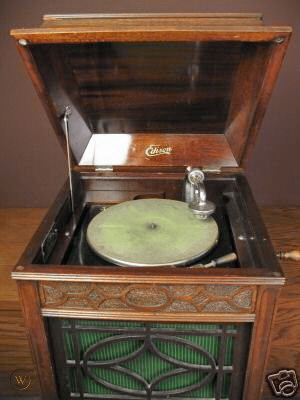Canadian Antique Phonograph Society

Edison apparently allowed the Aeolian Company to produce records that would play on his diamond disc machine. Vertical Cut Cylinders and Records , a book by Girard and Barnes, lists many classical records of this type, although I have never seen a list of Aeolian popular records of this type.
Before you could be reasonably sure that you had one of these records, you would have to test the record against the following criteria:
- the record must play as well or better on an Edison diamond disc machine than on any other machine;
- there must be no appreciable damage to the record resulting fram playing it on’ the Edison machine; and, most important of all,
- the Edison head must track properly with the arm engaged, showing that the grooves on the record are the same distance apart as the grooves on an Edison disc. (This is, of course, not true of most Hill-and-Dale records such as Pathe, Brunswick, Rex, etc.)
I have one Aeolian disc that qualifies. It has a brown, gold and black label on a black 10" record with the copyright date of 1916. The sides are labelled as follows:
| Aeolian | Al2001 | Ciribiribin |
|---|---|---|
|
Aeolian
|
B12001 | Santa Lucia |
(These numbers are repeated on the lead-off area of the record.) Both songs are sung by Fernando Guarneri, baritone. In addition, I have come across three other records that also fit the above criteria:
| Gennett | 7604-A | Andante from Organ Sonate (Matrix No. 1096a) |
| Gennett | 7604-B | Garney's Ideal (Matrix No. 1097a) |
Both are played by the Jones Brothers' Saxophone Band (made in New York).
| Gennett | 7613-A | Over There (Matrix No. 1l1lla) by Yerkes Jazarimba Orchestra |
| Gennett | 7613-B | Birds and the Brook (Matrix No. 121B) by Joe Belmont with orches- tra (made in New York) |
| Starr | 6501-A | Are You from Dixie? (Matrix No. 5022) |
| Starr | 6501-B | Loading Up the Mandy Lee (Matrix No. 5023) |
Both are sung by Harry Frankel with Roy Parks at the piano. (Starr: "Made by the Starr Piano Co., Richmond, Ind.")
These four records described above are all 10" black discs, thicker than the usual 78 but not as thick as an Edison Diamond Disc.
It is difficult to know what conclusion to draw from the above information. Were all three companies given "rights" by Edison? Or did they use the same number of grooves per inch, making their records compatible with the Edison disc machine, without telling anyone? (Edison may have quietly encouraged such a development in order that his machine might have a wider market.)
In any event, I cannot believe that the choice of a similar groove width by Edison, Starr, Gennett and Aeolian can be put down to coincidence.
It is also interesting to note that at least three of the four listed records date from 1917 or slightly later. This would be three or more years after the Edison Diamond Disc machine appeared on the market. This does not prove guilt on anyone's part, but does show that the Edison disc machine was available for experimentation and study for a reasonable length of time before the above records appeared.

